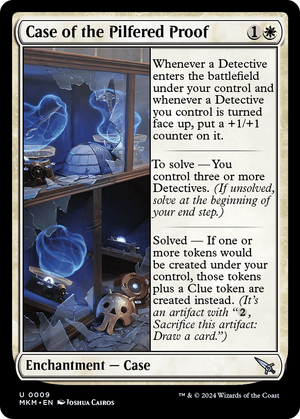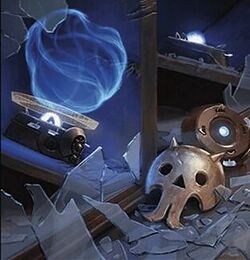Case: Difference between revisions
No edit summary |
>RivalRowan (Added rulings and image.) |
||
| Line 4: | Line 4: | ||
|stats={{stats|W=1|U=2}} | |stats={{stats|W=1|U=2}} | ||
}} | }} | ||
'''Case''' is an [[enchantment type]] to be introduced in ''[[Murders at Karlov Manor]]''. They represent mysteries to solve, and are the third type to use the vertical art and rules text design. | '''Case''' is an [[enchantment type]] to be introduced in ''[[Murders at Karlov Manor]]''.<ref>{{DailyRef|feature/murders-at-karlov-manor-mechanics|Murders at Karlov Manor Mechanics|[[Matt Tabak]]|January 16, 2024}}</ref> They represent mysteries to solve, and are the third [[card type]] type to use the vertical art and rules text design. | ||
==Description== | ==Description== | ||
Cases take after the design of [[Quest]]s, but with integrated rules rather than using [[quest counter]]s. | Cases are a variation on [[Saga]]s and [[Class|Classes]] that take after the design of [[Quest]]s, but with integrated rules rather than using [[quest counter]]s. | ||
Cases have three abilities, listed from top to bottom. The first ability is a standard ability, which has no rules attached to it. | Cases have three abilities, listed from top to bottom. The first ability is a standard ability, which has no additional rules attached to it. This ability is always active for its controller, regardless of whether or not the case is [[solved]]. | ||
The third ability is the "Solved" ability, which only takes effect if the case is marked as "solved". These implicitly have "Activate this ability only if [card name] is solved." or "As long as [card name] is solved, X". While players may mark these enchantments with counters to remind themselves of these changes of state, being solved is a designation that is either true or not and | The second ability is the "To solve" ability: it lists an intervening "if" condition for the player to achieve. The "to solve" ability triggers during its controllers [[end step]] but only if the condition has been met. Spelt out, it would read "At the beginning of the end step, if [condition], this Case is solved". | ||
The third ability is the "Solved" ability, which only takes effect if the case is marked as "solved". These implicitly have "Activate this ability only if [card name] is solved." or "As long as [card name] is solved, X". While players may mark these enchantments with counters to remind themselves of these changes of state, being solved is a designation that is either true or not and does not rely on external markers, much like Classes. | |||
==Rules== | ==Rules== | ||
<!-- {{CR|glossary|Case}} | <!-- {{CR|glossary|Case}} | ||
{{CR|111.10}} --> | {{CR|111.10}} --> | ||
==Rulings== | |||
[[File:Case of the Pilfered Proof.png|right|thumb|<c>Case of the Pilfered Proof</c> card.]] | |||
*The first ability of a Case is always active. | |||
*To solve a Case, its "to solve" condition must be true both as its controller's end step begins and as the "to solve" ability tries to resolve. | |||
*Once a Case is solved, it stays solved until it leaves the battlefield. | |||
**As long as it's solved, its "to solve" ability won't trigger again. | |||
**A Case remains solved even if another player gains control of it. | |||
==References== | |||
{{reflist}} | |||
{{Card types|nocat=1}} | {{Card types|nocat=1}} | ||
[[Category:Enchantment types| ]] | [[Category:Enchantment types| ]] | ||
Revision as of 23:55, 16 January 2024
| Case | |
|---|---|
| Enchantment Type | |
| (Subtype for enchantment cards) | |
| Statistics |
3 cards |
| Scryfall Search | |
| type:"Case" | |
Case is an enchantment type to be introduced in Murders at Karlov Manor.[1] They represent mysteries to solve, and are the third card type type to use the vertical art and rules text design.
Description
Cases are a variation on Sagas and Classes that take after the design of Quests, but with integrated rules rather than using quest counters.
Cases have three abilities, listed from top to bottom. The first ability is a standard ability, which has no additional rules attached to it. This ability is always active for its controller, regardless of whether or not the case is solved.
The second ability is the "To solve" ability: it lists an intervening "if" condition for the player to achieve. The "to solve" ability triggers during its controllers end step but only if the condition has been met. Spelt out, it would read "At the beginning of the end step, if [condition], this Case is solved".
The third ability is the "Solved" ability, which only takes effect if the case is marked as "solved". These implicitly have "Activate this ability only if [card name] is solved." or "As long as [card name] is solved, X". While players may mark these enchantments with counters to remind themselves of these changes of state, being solved is a designation that is either true or not and does not rely on external markers, much like Classes.
Rules
Rulings

- The first ability of a Case is always active.
- To solve a Case, its "to solve" condition must be true both as its controller's end step begins and as the "to solve" ability tries to resolve.
- Once a Case is solved, it stays solved until it leaves the battlefield.
- As long as it's solved, its "to solve" ability won't trigger again.
- A Case remains solved even if another player gains control of it.
References
- ↑ Matt Tabak (January 16, 2024). "Murders at Karlov Manor Mechanics". magicthegathering.com. Wizards of the Coast.
